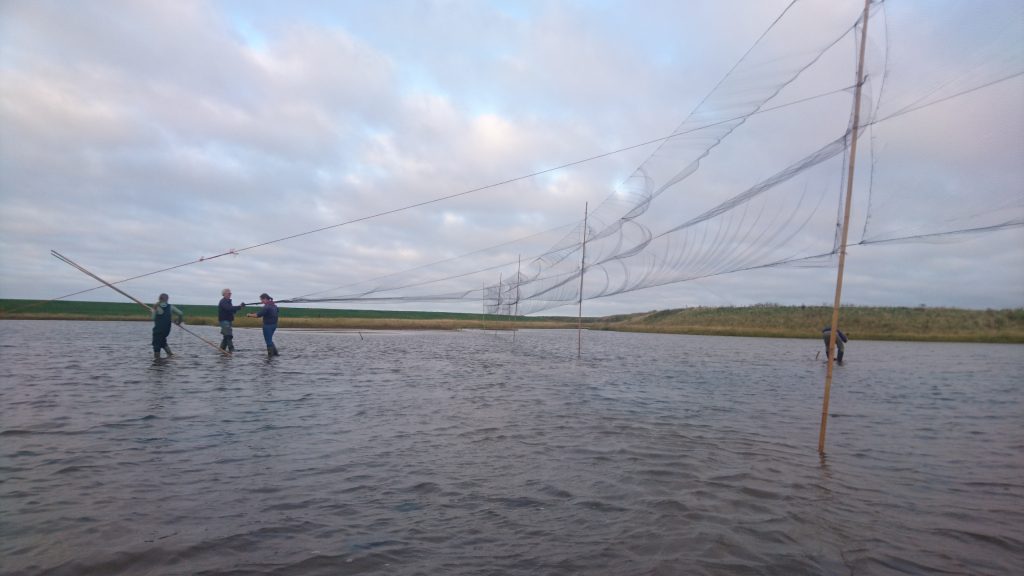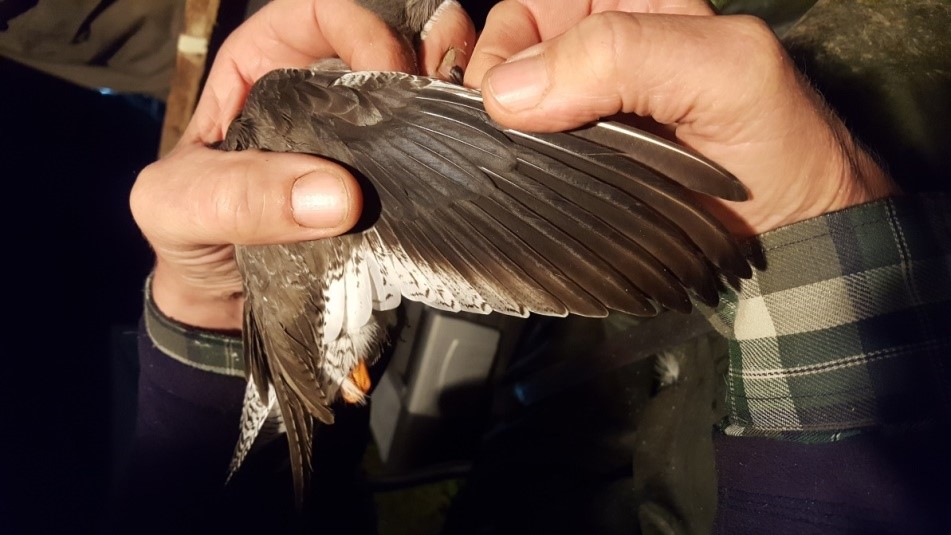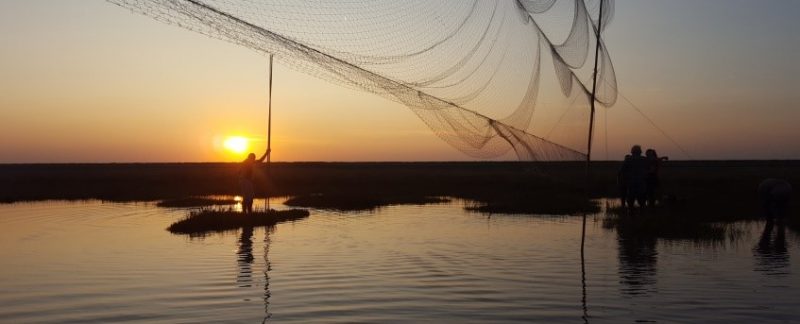There was a maximum of six people in each team at any one time and Covid-19 secure practices worked out for the August trip (see Fieldwork August 2020), and refined for the September trip, were followed at all times.
Saturday 19 September
With half of the Lincolnshire team turning up on Friday night, Saturday morning had been planned as a morning of recces. The plan was to be out 30–40 min before tide, since it was felt unlikely birds would look at fields before then. However, with strong NE wind and wave action, most of the saltmarsh was already under, making it more difficult to follow flocks as they left the marsh.
Jen and Mark were south of the Horseshoe looking at fields near Leverton down to the pumping stations and the outer reclaim. Katharine was up by the Horseshoe and nearby fields whilst Ros went for the Barley Mow Road area (hampered by the road to sea being gated and locked near the control tower). Ideally, we all hoped we’d see some good flocks of Curlew, Barwit and Grey Plover on fields and two potentially catchable flocks of Curlew were seen by Ros and Jen and Mark, whilst Katharine had large numbers (1,000 Knot) in the Horseshoe lagoon and passing north towards Ros. Steve went to our base to pick up kit before coming across to the campsite and we decided that we would set for Curlew on the field that Mark and Jen had identified at Leverton northern-most field – disced brassicas. Two small-mesh nets were set in a line. Rob joined us not long afterwards and we then all headed back to the campsite where a BBQ dinner was provided and the rest of the tents were set up. The wind was still too strong for mist-netting.
Sunday 20 September
We all got up relatively early to be at the nets two hours before high tide, with Jen and Mark in the hide (by 07:15), Katharine on the seawall towards the pumping station long stopping and the rest in cars further up the track. Ros went to move some gulls off a nearby field nearer to the nets to provide a nucleus and then stayed further over to provide extra information and be ready to move birds if needed. When the first lot of Curlew came off the marsh, a harrier was flying up the inland edge of the field, so many went north. We got a flock of 80 Curlew coming over who responded to the tape lure but landed c. 100 m from the nets. Whilst working out the best way to move them and starting to get Ros in a better position, a tractor came down with a man saying he needed a quick look at the sea wall. Sadly he proved not to have his mind changed when Steve spoke to him and he trundled down and, once out of his vehicle and on top of the sea wall, scared the flock off the field. His son soon turned up and did the same thing and it became apparent that things weren’t going to improve and the Curlew return, given how far they seemed to have gone and the passing of high tide. A decision was sadly made to stop, but we left the nets in place to attempt it again on Monday morning.
Rob went back immediately to look for the Curlew around the Horseshoe, finding them on a field to the north of the lagoon. It was thought that the tide would barely cover the marsh the following morning, so it wasn’t felt worth the effort to move the nets to this field. Everyone headed back to the campsite, Katharine went off to shop for dinner and later on in the afternoon Ros left and Josie arrived in her place. Soon after, Katharine cooked a chicken paprikash for everyone on the stove whilst the rest set nets on the pools (one T and a line of three on the Horseshoe and two two-shelf nets on the pool over the other side near the pumping station). Katharine then came across to join them whilst dinner was bubbling.

The word of the evening was ‘Thixotropic’ – an accurate description of the mud as it becomes hard when you hit it and soft when you push so putting pegs in and then getting them out is tricky in two different ways! Some attempts at describing the mud as haikus (a form of Japanese poetry) were made to add to other comments of the evening on getting the pegs in-(the other comments were not quite as polite!). We finished setting up the nets and Jen went back with the dogs as they were getting chilly to put on the rice and keep an eye on dinner. Then all back for food before Steve went out to set tape lures. It was still quite light when he heard a significant Knot flock come on to the lagoon, before that tape lure was on. We were soon very busy and had a good night with lots of birds (~140) and finished off at 02:00. We colour-marked the Knot, adding to our new scheme and also the one Greenshank, as part of Pete Potts’ scheme. It was very handy to just be able to fall straight into our tents without having to drive anywhere!
Catch totals
| Species | New | Retrap | Total |
| Oystercatcher | 7 | 0 | 7 |
| Ringed Plover | 1 | 0 | 1 |
| Grey Plover | 1 | 0 | 1 |
| Knot | 60 | 0 | 60 |
| Dunlin | 21 | 0 | 21 |
| Bar-tailed Godwit | 9 | 0 | 9 |
| Whimbrel | 1 | 0 | 1 |
| Curlew | 9 | 0 | 9 |
| Redshank | 22 | 0 | 22 |
| Greenshank | 1 | 0 | 1 |
| Turnstone | 9 | 0 | 9 |
| Totals | 141 | 0 | 141 |
Monday 21 September
Monday morning’s plan was to try again on the Curlew field at Leverton. We were all up to head off early and soon were over in position. Sadly we didn’t get any flocks of Curlew coming off the marsh, though Josie did move the nearby gull flock onto the field again to provide a nucleus. Once we realised it wasn’t likely to work, Steve headed off to Freiston to look for Redshank (five leg flags read) whilst the rest of us held on a little more before taking everything in. We then all went back to the campsite to rest plus dry a few things out from the night before. The rest of the afternoon was gentle and sleep-filled before making plans for the evening’s mist netting.
Rob left during this period and we gained Tim to help for the next couple of days. For the evening we headed north a little way before the control tower to set out on the marsh on the pools that Steve had tested last year. Katharine went to get a picnic dinner from the Co-op after we discovered that no fish and chip, kebab or pizza place was open on a Monday nearby!! With an E of nets set up (10 nets) and tape lures ready, the picnic supper was eaten before Steve and Katharine went out to put the tape lures on. Initially we had a slow start, but things rapidly picked up and the others came out to help – soon we were working away ringing and processing! Sadly the tide made a little more than expected, so a couple of people who opted for wellies after finding holes in their waders the night before got rather soggy and Steve took a tumble when tripping over a hidden tussock. We finished slightly early at 01:00-ish and were back at the campsite quicker than before having realised we could drive along the inner sea wall straight to the campsite.
Catch totals
| Species | New | Retrap | Total |
| Grey Plover | 5 | 0 | 5 |
| Knot | 12 | 0 | 12 |
| Dunlin | 25 | 0 | 25 |
| Bar-tailed Godwit | 17 | 4 | 21 |
| Curlew | 10 | 0 | 10 |
| Redshank | 62 | 2 | 64 |
| Turnstone | 5 | 0 | 5 |
| Totals | 136 | 6 | 142 |
Tuesday 22 September
Steve and Katharine left at 08:00 to go and look for Redshank at Freiston (11 leg flags and a Norwegian Oystercatcher seen) whilst the others got up a little later and put out the mist-netting kit to dry. A few of the others went to Skegness to walk the dogs and we all convened back after lunch to rest and relax and plan for the evening. Mist-netting was at Freiston where, though good weather, fewer birds turned up with only 35 being caught in two sets of nets (a T of Ecotone and a curve of three French nets). However, we were able to colour-mark another sample of Redshank and a few more Knot – interestingly, we caught a Redshank with 11 large primaries (photo). Dinner of chilli and rice was provided on site by Jen. Then we all went our separate ways with Steve heading to our base with the equipment, Mark and Jen camping at Freiston and Katharine, Josie and Tim going back to the tents to leave in the morning.

Catch totals
| Species | New | Retrap | Total |
| Grey Plover | 1 | 0 | 1 |
| Knot | 3 | 0 | 3 |
| Dunlin | 1 | 0 | 1 |
| Black-tailed Godwit | 1 | 0 | 1 |
| Redshank | 27 | 0 | 27 |
| Turnstone | 2 | 0 | 2 |
| Totals | 35 | 0 | 35 |
Trip ringing totals – Lincolnshire
| Species | New | Retrap | Colour-marked | Total caught |
| Oystercatcher | 7 | 0 | 7 | |
| Ringed Plover | 1 | 0 | 1 | |
| Grey Plover | 7 | 0 | 7 | |
| Knot | 75 | 0 | 74 | 75 |
| Dunlin | 47 | 0 | 47 | |
| Bar-tailed Godwit | 26 | 4 | 30 | |
| Black-tailed Godwit | 1 | 0 | 1 | |
| Whimbrel | 1 | 0 | 1 | |
| Curlew | 19 | 0 | 19 | |
| Redshank | 111 | 2 | 25 | 31 |
| Greenshank | 1 | 0 | 1 | |
| Turnstone | 16 | 0 | 16 | |
| Totals | 312 | 6 | 99 | 318 |

